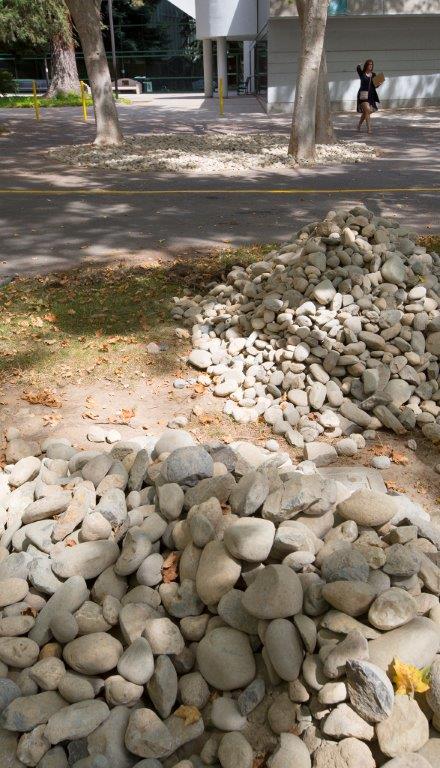 Rock landscaping on campus offers smart, sustainable gardening during California's prolonged drought. (Sacramento State/Steve McKay)
Rock landscaping on campus offers smart, sustainable gardening during California's prolonged drought. (Sacramento State/Steve McKay)Sacramento State’s 300-acre campus is home to one of the region’s most beautiful urban parks – boasting 3,500 shade trees across what was once more than 90 acres of lawn. As California plods through a fourth summer of severe drought, the University is escalating its already aggressive efforts to conserve water while preserving the campus’s beloved trees.
“We’re continually doing more and more projects that involve taking out turf and shutting down sprinklers,” says Paul Serafimidis, director of Sustainability and Plant Operations. “We’re putting in native plants that add color as well as needing less water. And, we’re letting the grass go in some places and watering trees with bubblers rather than sprinklers.”
Grounds crews have shut down more than 750 sprinkler heads on seven treeless acres, which will save more than 2.4 million gallons of water annually. Wood-chip mulch scattered around the trees helps to retain moisture, reduce the need for frequent irrigation and maintain the magnificent canopy that prompted the Arbor Day Foundation to name Sacramento State a “Tree Campus USA.”
This summer, the LID (Low-Impact Development) storm-water management project will bring bioretention planters, rain gardens and compost-amended bioswales to various parts of the campus. The installations will replace existing turf and pavement, allowing storm water to infiltrate and recharge the underlying groundwater used for campus irrigation. The $3.5 million project is funded in part by a $2.8 million grant from the State Water Resource Control Board.
Sacramento State’s ongoing water conservation efforts also include:
- A new and more efficient sprinkler-control system allows crews to schedule lawn irrigation remotely and automatically and make it easier for them to determine when and how much watering is needed.
- Only non-potable water from the University’s five wells is used for irrigation. Sac State reduced irrigation by 37 percent over the last year.
- Broken sprinkler heads are being replaced with more efficient heads that minimize overspray and reduce water usage by 30 percent.
- Native and drought-tolerant plants are used in new landscaping projects. Rocks or decomposed granite take the place of turf near walking paths.
- The University has replaced 519 old, water-wasting bathroom fixtures in buildings across campus. The new toilets use just 1.28 gallons of water per flush, and the new urinals use only a half-gallon. More than half of the project’s cost was paid for with a $78,000 grant in Proposition 50 funds from the City of Sacramento.
- Replacing the flush valves on another 437 fixtures is expected to reduce water usage by 10 percent.
- New faucet aerators on all bathroom sinks have decreased water output to a half-gallon per minute, compared to two gallons per minute with the old aerators.
- Water meters are being installed on all campus buildings.
- The decorative fountains in front of the University Library and just east of the University Union will remain dry for the duration of the drought.
- Native plants and decorative boulders have replaced grass in several areas of campus, with low block walls providing seating in these new, minimalist gardens.
- Lifeguards cover the campus swimming pool at the end of each day to prevent evaporation. A $10,000 incentive grant from PG&E paid for the motorized cover.
- Sac State’s Sustainability team continues to educate the campus community about conserving water with lawn signs, electronic-monitor displays and stickers on bathroom mirrors. Water conservation was a theme of the 2015 Earth Day celebration, and the team led the University’s Water Conservation Awareness Day in September 2014. – Dixie Reid
